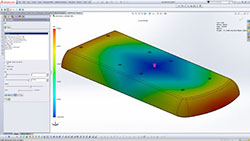 Since implementing SOLIDWORKS® Professional and SOLIDWORKS Premium design software in 2001, the Idahobased company has realized dramatic productivity gains, cutting design cycles and expanding its product offering. The implementation of the SOLIDWORKS Enterprise PDM product data management system in 2010 produced additional benefits. In 2012, ECCO turned to Dassault
Since implementing SOLIDWORKS® Professional and SOLIDWORKS Premium design software in 2001, the Idahobased company has realized dramatic productivity gains, cutting design cycles and expanding its product offering. The implementation of the SOLIDWORKS Enterprise PDM product data management system in 2010 produced additional benefits. In 2012, ECCO turned to Dassault
Systèmes SOLIDWORKS Corporation for a solution for optimizing the manufacturability of plastic injectionmolded parts.
“Prior to 2012, we relied on our tool manufacturer to spot and address injection-molding issues,” recalls Mechanical Design Engineer John Aldape. “However, when we received glass-filled nylon alarm enclosures with surface-knitting issues, we decided to investigate mold-filling simulation technology. We wanted to independently assess how a mold would fill and where knit lines would be, instead of waiting on
iterations with the toolmaker.”
 ECCO obtained SOLIDWORKS Plastics Professional injectionmolding simulation software. “The software showed us enough that we knew it would be valuable,” says Mechanical Design Engineer Nick Thompson. “SOLIDWORKS Plastics is easy to use, simulates how the plastic will fill the mold, and shows how the molded part will look. We realized that we could use it to avoid manufacturability issues.”
ECCO obtained SOLIDWORKS Plastics Professional injectionmolding simulation software. “The software showed us enough that we knew it would be valuable,” says Mechanical Design Engineer Nick Thompson. “SOLIDWORKS Plastics is easy to use, simulates how the plastic will fill the mold, and shows how the molded part will look. We realized that we could use it to avoid manufacturability issues.”
“We also foresaw how SOLIDWORKS Plastics would help us refine the production of optical components, such as lenses,” Aldape adds. “We want our parts to be smooth, clean, and structurally sound, and we believed SOLIDWORKS Plastics would help us achieve those goals.”
SIMULATING MOLD FILLING SAVES TIME AND MONEY
ECCO uses SOLIDWORKS Plastics mold-filling simulations to optimize plastic injection-molded parts on the front end, which saves time and money by minimizing iterations with the moldmaker on the back end. The company still values the expertise of its tool manufacturer, but having access to moldfilling simulations during design keeps potential manufacturing issues to a minimum.
“Although we still leave things like mold inserts, sizes, forms, and the presses required to the toolmaker, being able to visualize how the plastic will flow in the mold gives us greater control over how the final part will look,” Aldape notes. “If we didn’t have SOLIDWORKS Plastics, we wouldn’t have as much confidence in the manufacturability of a design. It helps us avoid going back and forth with the moldmaker after the fact, which saves time and reduces costs.”
INCREASING THE FLOW OF PLASTICS IN MOLDS
ECCO first used SOLIDWORKS Plastics to develop a new base for its four-foot and six-foot emergency light bars. After using SOLIDWORKS Simulation structural analysis results to increase the stiffness of the base by adding ribs, fins, and ridges, Thompson used SOLIDWORKS Plastics to simulate mold filling, which led to additional design changes to optimize manufacturability.
“The light bar base was the largest injected-plastic part that we have made,” Thompson says. “With SOLIDWORKS Plastics, I was able to modify the design to improve the flow of plastic in the mold. I added a large post for the injection sprue and ribs heading out from the post to serve as runners to improve flow. Instead of having to go back and add runners, which would have resulted in a delay, I had already done it. All the moldmaker had to do was change a gate dimension.”
